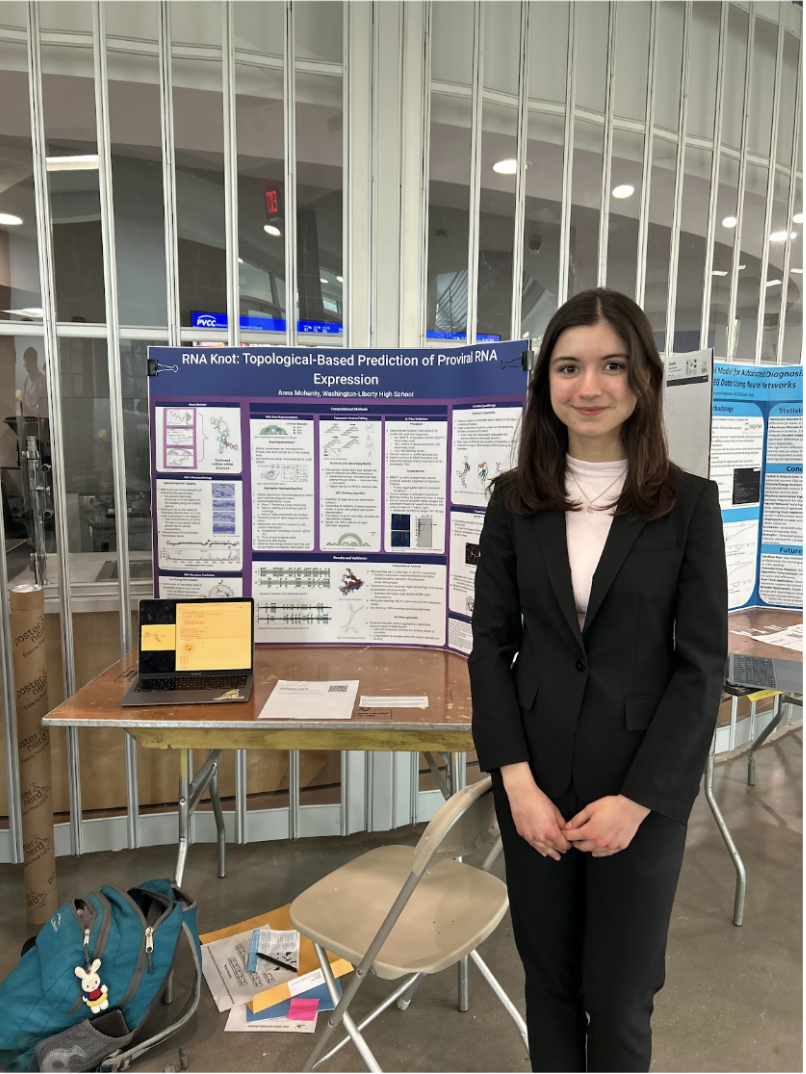
Over 30 students are advancing to the regional science fair in early March after participating in the school science fair. The science fair was initially scheduled for Saturday, Jan. 20, but it was canceled due to snow. Due to the quick deadline for presentations, students presented during school days the following week. Mr. Jason Brodowski, a regular and intensified biology teacher at the school, ran the science fair this year after he took over for Ms. Crystal Liller.
“[The students] actually did a bunch of presentations during their free periods, lunch period[s], after school, before school, GP, … [in] 20 different classrooms,” said Mr. Brodowski. “They just showed up like rock stars and did their presentations during midterms week. I’m just blown away by those guys.”
Originally, each student would have presented to a panel of three judges, but the inclement weather thwarted this as the school was closed due to projected snow.
“We had judges from all over the place that were supposed to be here on Saturday,” said Mr. Brodowski. “I mean, the community just went nuts. We had so many people volunteering. Actually, I think this is like one of the years we had to say, nope, we’ve got enough judges.”
Unfortunately, it was simply not possible to reschedule with judges from the community, so a number of the school’s teachers stepped in to help. Each student who took part in the science fair could present to two different teachers who judged the students’ projects.
Mr. Brodowski is hopeful that next year, the school will be able to hold a more traditional science fair for everyone. However, this year’s new format did offer some benefits. Mrs. Dawn McCoart, who currently teaches AP and intensified biology, was one of the teachers who judged science fair projects. She explained that she appreciated learning more about students’ projects due to the altered format of presentations.
“When we do the science fair in the cafeteria, I usually walk around and I’ll ask a few kids a few questions, but they’re getting ready to be judged, and I don’t want to get them stressed out,” said Mrs. McCoart. “I’ll try to go in after the judging and check them out, but it was more fun to just listen to the whole thing.”
As a judge, Mrs. McCoart got to learn about several science fair projects.
“That was probably my favorite part: [to] actually interact with the kids and listen to their projects,” said Mrs. McCoart. “I saw some really great projects. … A lot of them are going to regionals, and I hope they have a great time [there].”
One of the students moving on to the regional fair is junior Anna Mohanty. She is disappointed that the school was forced to alter its science fair plans but is glad that she will get more of the traditional science fair experience at regionals.
“I personally always preferred the normal setup where everyone’s projects are within one place, or there’s a panel of judges because I feel like they can bounce ideas off one another, and it creates a really good discussion around your project,” said Mohanty. “I also always loved seeing other people’s projects and getting to discuss with them. … But this is the best way they could do it with the snow day.”
Mohanty’s project looked at how spiders can be used to fight HIV.

“What I was looking at originally was diseases and viruses that affect the silk production industry because my family’s from North India, and that’s a really big industry there and viruses that affect silk producers are a huge problem to the economy,” said Mohanty. “Then when I was researching that, I was finding that a lot of these viruses that can infect the silk glands of silk producers have very similar structure to HIV 1 that infects humans.”
In order to study this further, Mohanty trained her own AI model.
“What I essentially did was I trained an AI model based on different parameters to be able to predict how well a drug would be able to bind to its target within an HIV 1 infection in the brain,” said Mohanty. “The way that two proteins twist to allow HIV 1 to spread throughout the brain … is also very similar to the way that spider silk twists. So the real world application is using cheap drugs that can be found in spider digestive systems to effectively fight HIV.”


She has found a lot of support from the school’s teachers and shared that many of the science teachers have helped train and prepare her for higher levels of science fairs beyond the school.
“They were always very helpful,” said Mohanty, “but especially now when I’ve been doing more advanced projects, they’ve been really helpful in supporting me and finding a way to make the presentation coherent and also helping me to find different research opportunities.”
Mohanty added that the school science fair is a good starting point for anyone hoping to participate in more competitive science fairs, such as regionals or states. She finds them valuable experiences because they let students share their research with others, which is especially beneficial for students interested in pursuing a career in STEM.
“I think the act of completing a research project and then being able to present it in a way that showcases what you learned from it and what the scientific processes were behind it is just really fundamental to all of science,” said Mohanty. “So, [science fair is] a really good way to practice that if you want to go into a STEM discipline.”
Freshman Sabrina Yimer is also attending the regional science fair on March 2. Her project this year was a continuation of previous research and experimentation.

“Last year I tested the impacts of inorganic and organic fertilizer on algae growth. [The] conclusion made was that … organic fertilizer is just as bad as inorganic fertilizer, [so] scientists should instead reduce fertilizer runoff directly,” said Yimer. “My experiment this year was different types of soils’ impact on fertilizer runoff and algae growth.”

Yimer explained that to get inspiration for her project, she thought about problems that she thought were important.
“Climate change is always a big [problem] and whenever you learn about climate change, people are like, oh, fertilizer runoff, fertilizer runoff,” said Yimer. “I guess somewhere in my mind, I always felt like, oh, why don’t people just use organic fertilizer? … I was like, does it make a real big difference?”
Yimer shared that the science fair is a way to engage in the evolving field of science in meaningful ways, even if the impact is small.
“Whenever you hear of scientists, you always hear of these super intelligent people who discover something new, but science fair kind of makes it easily accessible. You are learning something new, and then … science research is learning something and continuing to apply that so you can learn more about the topic.”
As for the challenges, those would be picking a topic and sticking with it.

“The hardest part is … two things. One is choosing a topic, because there’s like a million things that you can be interested in, but you have to look specifically into one topic,” said Yimer. “Then, the second hardest [part] would probably just be continuing to do [it], just being resilient, because there’s so many parts of science fair.”
However, a science fair can still be an enriching and worthwhile experience.

“The most rewarding part would probably be presenting [your project],” said Yimer. “It’s really nice, especially when you’re presenting with judges, and to parents and teachers, … and your work finally shines through … [It] just feels rewarding when you realize that you can share all your research and work together.”
To that end, Mr. Brodowski encourages anyone remotely interested to participate in the science fair in the future.
“There’s nothing like seeing the kid present, you know,” said Mr. Brodowski. “Technically a kid could just write his paper, send it in; that’s it. But it’s when the kid talks about it, you see their enthusiasm, you see their excitement about it, their curiosity, … it just comes across in their presentation. … And it’s just so exciting to see.”
He added that students can find a lot of support along the way at the school.
“There’s so many teachers that will help you with the science fair,” said Mr. Brodowski. “You don’t have to confine yourself to a science teacher. Go to a history teacher. Go to an English teacher. … You gotta remember, the history guys are the best at researching [and] that’s the basis of starting the science fair. And the English guys [can] help you with the English part of it, the writing part of it. … The science, we can help you with that. And the math guys, oh my gosh, they can help you with all the statistics. So the school is just ready to help you. You just come with that curiosity, and we can go from there.”
Mrs. McCoart expressed similar sentiments and explained some of the benefits of participating.
“It teaches [students] a lot of stuff,” said Mrs. McCoart. “It teaches them how to write. It teaches them how to think critically. It teaches them how to analyze data, how to look at data and decide if it’s going well or not … And, if something’s not going well, they have to meet that challenge and figure out how to fix it. So it gives them problem solving skills as well.”
In addition to learning these skills, science fair requires an inquisitive mind.
“Science is based on curiosity. It’s not based on eureka. It’s based on, ‘hmm, that’s weird,’ and you want to investigate it,” said Mr. Brodowski. “Every teenager has that skill. …You want to figure something out, and you want to go out there and try to understand it better. … So, if you have that curiosity, do it.”













